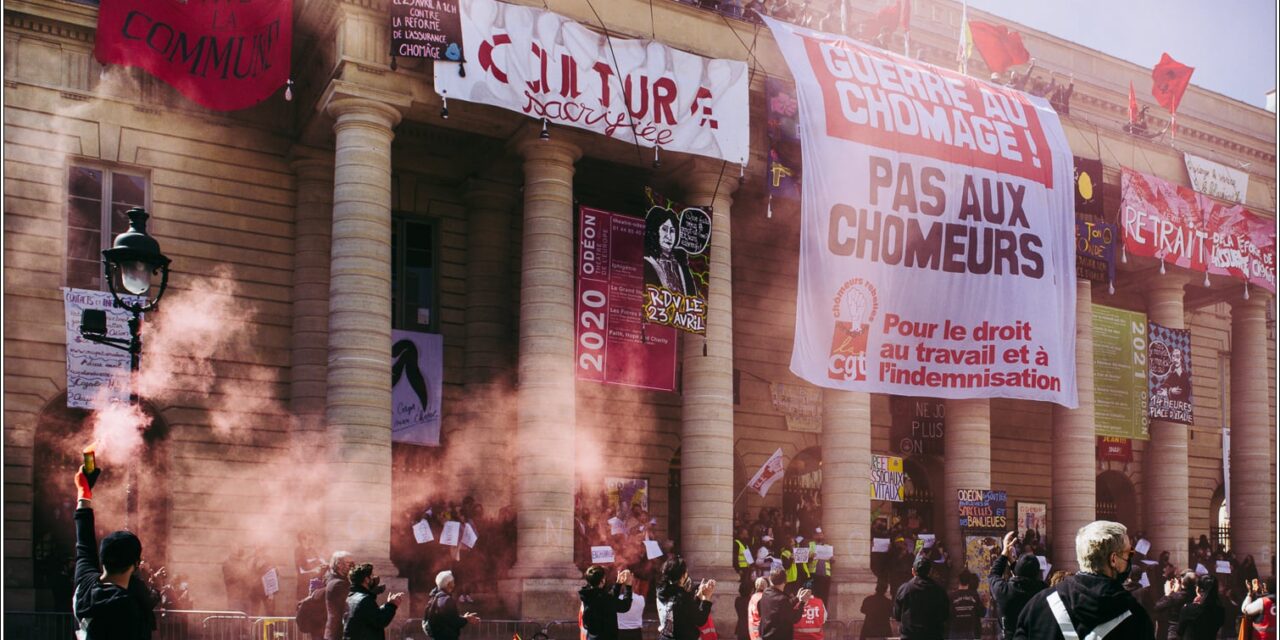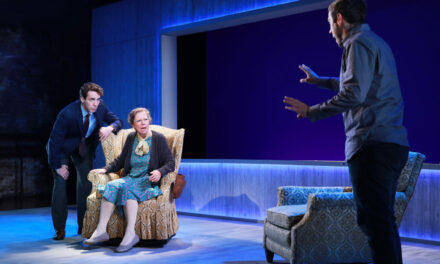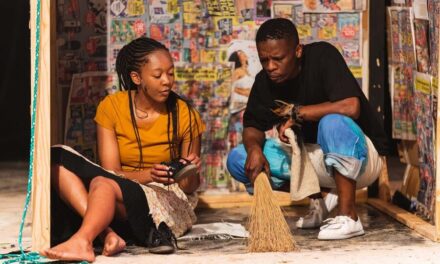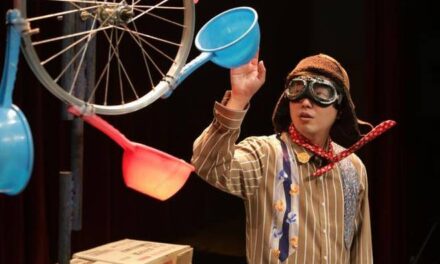History, as they say, has a habit of repeating itself. When French theatre-makers seized hold of and occupied the Théâtre de l’Odéon in Paris for two and half months between March and May 2021, they were building on what had come before. Back in May 1968, the Odéon was besieged by workers and students united in the fight against Gaullist capitalism and the death of culture by consumerism. In 2021, the Odéon protesters similarly alerted the public to the reforms led by Emmanuel Macron’s neoliberal government, which look set to plunge thousands of France’s cultural industry workers into financial difficulty. Through the steel bars of the theatre’s grandiose entrance, the self-declared “agora of the Odéon” (a name also used in ’68) put on music, dancing, poetry, and recitals to communicate their plight.
If I mention these details, it is because they frame the first play staged at the Odéon since the end of the 2021 occupation in site-specific ways. Tennessee William’s 1944 play Glass Menagerie is about a struggling family in Great Depression-era America, a precursor to our current, COVID-19-inflected, difficult times. This new production, by Belgian director Ivo van Hove, is a testament to the power of dreams and hope to lift the spirits even in the direst of economic straits. The casting choices also have us thinking about the popular movement swelling around this historic site of theatrical protest.
Velvet Revolts
In 1968, the Odéon’s occupants turned to the American counter-culture as a source of inspiration for a non-consumerist version of theatre. The Living Theatre even counted itself among the theatre’s temporary inhabitants.[i] Van Hove’s 2021 production marks a return, of sorts, to American theatre as a muse of French protest. Seeking to give more visibility to their movement, the occupiers stated their desire to remain in the Odéon while Glass Menagerie had its run. Their request was denied, the theatre’s current artistic director Stéphane Braunschweig remarking that the close mingling of protesters and spectators would prove too much of a health risk during this time of the pandemic.
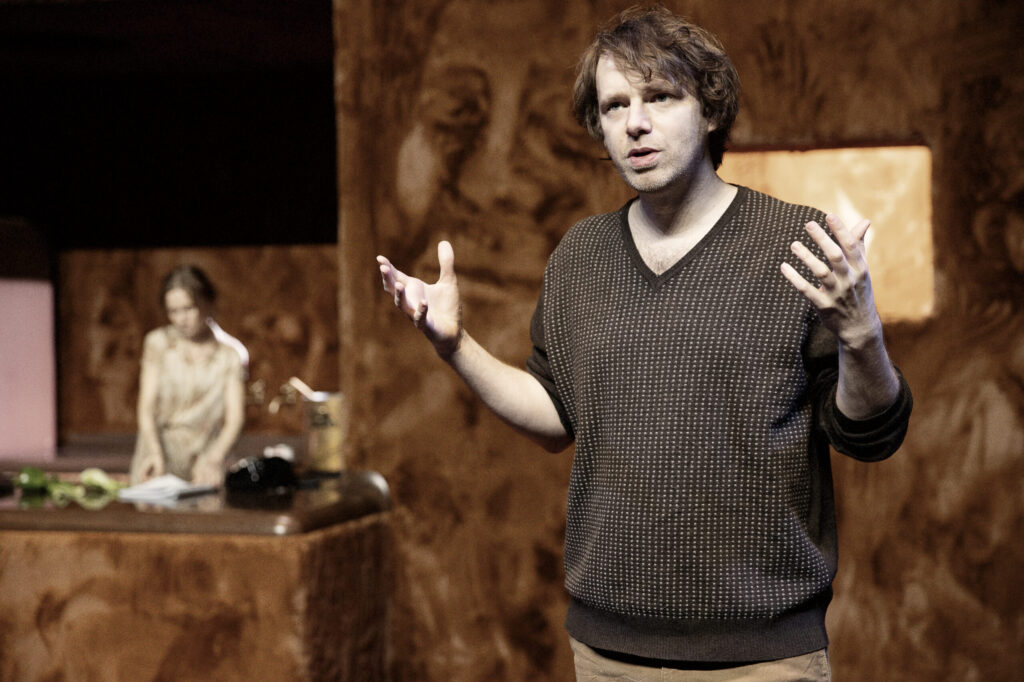
Jan Versweyveld’s sumptuous set design features the faint outline of nameless faces emerging from a rich brown velvet backcloth. Antoine Reinartz as Tom Wingfield in the foreground; Isabelle Huppert as Amanda Wingfield in the background. © Jan Versweyveld.
We might muse on the convergences and connections that could have played out had Glass Menagerie and Occupy Odéon been allowed to cohabit. After all, the play’s theme of Great Depression-era difficulties resonates with our very own “trying times”.[ii] The play takes place in the apartment of the Wingfield family, a small, “cellular living-uni[t]” of a “vast hive-like” building in Saint Louis, Missouri.[iii] In Van Hove’s production, the smallness of space is captured by a black safety curtain that blocks two-thirds of the Odéon’s formidable proscenium arch from our sight. A velvet tapestry lines the family apartment. Out of this emerge the faint outlines of numerous anonymous faces. These replace the imposing photograph of the absent family patriarch detailed in Williams’ text. Jan Versweyveld’s sumptuous and stunning set design seems a spectral return to art of the Great Depression. One motif favored in 1930s American art was, similarly, the dignified and determined faces of innumerable nameless laborers.

American Depression art similarly featured numerous anonymous faces as a translation of the dignity of workers in hard times. Fletcher Martin, detail of San Pedro Post Office mural, San Pedro, California (Works Progress Administration), c. 1935.
Had Occupy Odéon and Glass Menagerie commingled, these faces might have been a poignant reminder of the anonymous workers who remain behind the scenes in theatre—the carpenters, associated set designers, stage crew, pattern cutters, and countless others whose names disappear under those of the head technicians in any theatre program. But the Occupy Odéon protesters had decamped days before, partly under the pressure from the public which had been led to believe (erroneously) that it was the social movement that was preventing Glass Menagerie from opening. As it is, then, the luster of the brown tapestry seemed to say more about the play’s characters than the outside protests. A visual metonymy of the hopes, dreams, and aspirations held by each of the play’s four characters, the décor enacted a similar “Midas touch” transformation from drab to dazzling that family matriarch Amanda Wingfield recalls one of her admirers having back in her youth.[iv] The velour visages emerging from the backcloth were also an example of “pareidolia”, conjuring up the “intense fragility” of each character described in the press pack.[v] They could disappear at the stroke of a hand just as the reveries of each character are periodically pierced by the reality of the Great Depression and of the looming world war.
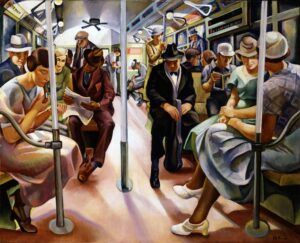
More anonymous faces in American art of the Great Depression. Lily Furedi, “The Subway”, oil on canvas, 99.1 x 122.6 cm, Smithsonian American Art Museum, 1934.
Formed by fibers carefully swept into various directions, the velvet faces also imply motion, even if they are, technically, fixed images. They reflect Tennessee Williams’ conviction that the theatre is a living artform able to recast the fixed realism depicted in photography (of which Williams was suspicious). In the era of the American Depression, this realism was often sobering in its bleakness.[vi] The actors also encapsulated the plastic qualities of the theatrical form that Williams believed could transform reality, using gesture and movement as their (sole) means of revolt in impoverished times. Antoine Reinartz, playing the Wingfield son Tom, forms graceful patterns in the air with a magician’s cloth; Justine Bachelet, in the role of his painfully shy sister Laura, wraps her body around her brother in tenderness and admiration of his stories of the outside world. Cyril Gueï, as Tom’s fellow factory worker Jim, dances with his shadow, Peter-Pan-like, on the wall. Jim (Gueï) and Laura (Bachelet) lose themselves in the grooves, jives, and lifts of their dance sequence, as Jim insists to Laura that she must overcome her “inferiority complex” just as he had gained self-confidence by taking evening classes in public speaking.[vii]
Casting Choices
Back in 1968, the Odéon’s occupiers opposed the famous “stars” who were turning culture into consumer products. Jean-Louis Barrault, the renowned personality, and the Odéon’s then-artistic director, even declared himself “dead” in a bid to gain the protester’s sympathy.[viii] During the Odéon occupation of 2021, the lead role in Glass Menagerie Isabelle Huppert came under attack for a similar reason. An established French star of cinema and theatre, Huppert was far removed from the economic precariousness facing those lower down in the cultural industry hierarchy.
Throughout the production run, Huppert remained eerily silent on the protest movement swarming around the Odéon. Though I have long admired Huppert’s skills as an actor, her star aura bled into her performance in a way that resonates with Augusto Boal’s Theatre of the Oppressed. For Boal, such protagonist-stars are a sign of the “aristocrati[zation]” of theatre and are counterproductive to a popular form of theatre that serves social protest. The main actor distinguishes him or herself from a popular dithyrambic celebration and “the chorus, the mass, the people” that theatre, at its origin, once was.[ix] Huppert is similarly made to stand out from the crowd in her incarnation of the play’s “central and most interesting character” (the press pack’s description), as the mother to Tom and Laura, Amanda Wingfield.[x]
The family matriarch of Williams’ play is a complex character, at once a faded Southern belle with racist conceits, nostalgic for former times when servants waited on her; and a woman struggling to make ends meet, desperate to see her daughter married off or gain some independent income before poverty hits. Huppert moved audiences to laughter and empathy in her characterization, but at certain points, her star persona obscured rather than enhanced the complexities of Amanda Wingfield. When the latter’s dinner guest Jim O’Connor (Cyril Gueï) informs his host of his betrothal and subsequent unavailability to marry daughter Laura, Huppert stares impassively at him in a sustained pause. This blank reaction is a staple of Huppert’s cinematic repertoire. In films from The Lacemaker (Claude Goretta, 1977) to Gabrielle (Patrice Chéreau, 2005), Huppert’s expressionless demeanor has allowed the actress to inflect the seemingly hopeless women characters she plays with a degree of power.[xi] Yet it rings hollow in Glass Menagerie not least of all because the text reminds us that “Southern hospitality”, which Amanda Wingfield masters, does not extend to “stand-offish” behavior.[xii]
This is not a plea for fidelity to the text. Transcultural alterations are important for foreign texts to translate meaningfully in their host countries. But it is one example of Huppert’s domination of the stage through her star persona, which at times eclipses the performances of the other actors. Another example is when Amanda Wingfield (Huppert) regales Jim (Cyril Gueï) with her dreams of returning to her youth among the rich planters “with plenty of servants”.[xiii] The spotlight, simulating pale blue moonlight, was firmly on Huppert at this point. This may highlight the solipsism of Amanda Wingfield, lost in her naïve view of the past. However, it also seems a missed opportunity for new meaning to accrue to the scene. Jim is played by French actor of Ivorian descent Cyril Gueï. The actor does not ostensibly react to Amanda’s comments about her many “servants”, a racially loaded term in Jim Crow era America.
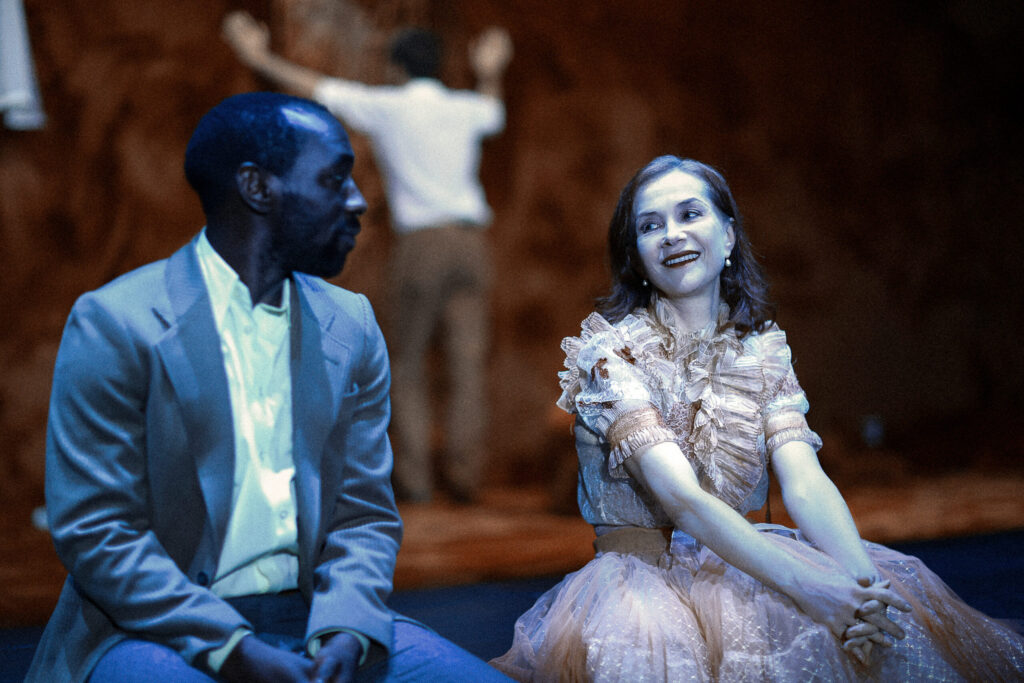
Cyril Gueï plays Jim O’Connor. Amanda Wingfield is played by Isabelle Huppert. © Jan Versweyveld
This lack of reaction may be a self-conscious survival strategy deployed by the actor himself. My interpretation of the moment is inevitably marked by the limiting frame of my white identity. I do not wish, moreover, to reduce Cyril Gueï’s performance in Glass Menagerie to what he may or may not represent about racial identity in this production. Having collaborated with Peter Brook and film director Claude Chabrol, Gueï is a seasoned actor and he is compelling in the role of Irish Catholic character Jim. He is not simply “an emissary from the world of reality” as the text describes but also a hopeful dreamer and Laura’s tender mentor. However, as Brandi Wilkins Catanese describes in her book, The Problem of the Color[blind]: Racial Transgression and the Politics of Black Performance (2011), casting racialized actors in roles not conceived for them will inevitably lead spectators of American and European societies marked by the legacies of colonialism to “see” race in these characterizations. As she states, actors who are cast against racial type “always illuminate the racial ideologies that they defy”.[xiv]
So-called “color-blind casting” (a hotly debated term in itself) can run the risk of sowing false beliefs that the theatre industry is somehow “post-racial”, beyond susceptibility to racial discrimination that defines our wider society. Catanese, therefore, calls for a form of “color-blind casting” that is carefully framed in order to avoid falling “prey to a false innocence or naïve ahistoricism that emphasizes its transcendent possibilities”.[xv] Glass Menagerie director Ivo van Hove is a connoisseur of American theatre, having staged plays by Eugene O’Neill, Arthur Miller, and Tony Kushner before this. Yet, in the press pack, he does not mention the racial tensions in this Tennessee Williams play—specifically, poor whites such as Amanda waxing nostalgic for a time when her social capital depended on the subordination of African Americans. He favors instead a reading of American theatre as the stage for “universal” conflicts played out between all individuals’ desire for self-affirmation versus their need to integrate into society.[xvi] This would seem to do little to sharpen the critical sensibilities of the Odéon’s mostly-white theatregoers on how cross-racial casting might operate to trouble racist ideas in Glass Menagerie.
Van Hove’s comments come as no surprise. “Seeing” race is anathema in France, a country whose Republican ideology deliberately downplays difference and emphasizes universalism and sameness. The French malaise for talking through issues relating to race and racism might also explain why the Occupy Odéon movement has thus far been dominated by white theatre-makers, and why it has remained separate from the Décoloniser les Arts (“Decolonize the Arts”) collective active in France since 2015. But discussions about race and racism in Glass Menagerie need to happen in this country. As Dirk Grindt has shown, Tennessee Williams’ plays have a history of contributing to white complacency here. French audiences watching Williams’ plays have been falsely reassured that they are nothing like the overtly racist Americans of the Deep South (such as Amanda Wingfield) that they watch on the stage.[xvii] Since, as we have seen, history has a habit of catching up with the Odéon theatre, a future pathway might be to challenge the reception history of Tennessee Williams’ plays in France with the Odéon’s own legacy as a hub of popular protest and theatrical revolution.
NOTES
[i] Marie-Ange Rauch, Le Théâtre en France en 1968 (Paris: Éditions de l’Amandier, 2008), p. 195.
[ii] Tennessee Williams, The Glass Menagerie (1944). PDF version, 28. https://www.pval.org/cms/lib/NY19000481/Centricity/Domain/105/the_glass_menagerie_messy_full_text.pdf (accessed 16 June 2021).
[iii] Ibid, 1.
[iv] Ibid, 5.
[v] Pareidolia describes the phenomenon by which viewers map perceptual interpretations onto unclear visual sources. Press pack, “La Ménagerie de verre 19 mai – 9 juin,” 2021, 9. https://www.theatre-odeon.eu/media/odeon/187635-dp_la_me_nagerie_de_verre.pdf (accessed 16 June 2021).
[vi] Ibid., 10. An example of this bleak photographic realism is Dorothea Lange’s iconic 1936 image of the Migrant Mother.
[vii] Glass Menagerie, 93.
[viii] Rauch, 200-201.
[ix] Augusto Boal, Theatre of the Oppressed (London: Pluto Press, 1979), 29.
[x] Press Pack, 10.
[xi] Lara Cox, “Going Global: The Stars of French Theory and French Cinema,” Journal of Romance Studies 12, no. 2 (2012): 59-74
[xii] Glass Menagerie, 111, 69.
[xiii] Ibid., 70.
[xiv] Brandi Wilkins Catanese, The Problem of the Color[Blind]: Racial Transgression and the Politics of Black Performance (Ann Arbor: The University of Michigan Press, 2011), 68.
[xv] Catanese, 67.
[xvi] Press Pack, 5.
[xvii] Dirk Gindt, Tennessee Williams in Sweden and France, 1945-1965: Cultural Translations, Sexual Anxieties and Racial Fantasies (Bloomsbury, 2020), 38.
This post was written by the author in their personal capacity.The opinions expressed in this article are the author’s own and do not reflect the view of The Theatre Times, their staff or collaborators.
This post was written by Lara Cox.
The views expressed here belong to the author and do not necessarily reflect our views and opinions.

